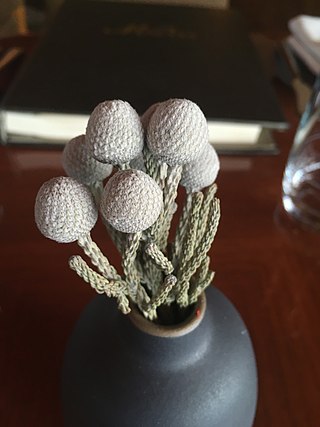
Sisyrinchium is a large genus of annual to perennial flowering plants in the family Iridaceae. Native to the New World, the species are known as blue-eyed grasses. Although they are not true grasses (Poaceae), they are monocots.

Dietes is a genus of rhizomatous plants of the family Iridaceae, first described as a genus in 1866. Common names include wood iris, fortnight lily, African iris, Japanese iris and butterfly iris, each of which may be used differently in different regions for one or more of the six species within the genus.

Diplarrena is a genus of flowering plants in the family Iridaceae. The two species are endemic to Australia. The name is from Greek diploos ("double") and arren ("male"); plants in the genus have only two functional stamens, while all other Iridaceae have three. The name is often misspelled Diplarrhena, an error that began with George Bentham's Flora Australiensis in 1873.
Moraea garipensis is a species of flowering plant in the family Iridaceae. It is endemic to Namibia. Its natural habitats are subtropical or tropical dry shrubland and rocky areas. It is threatened by habitat loss.

Moraea, the Cape tulips, is a genus of plants in the family Iridaceae, first described as a genus in 1758. The group is widespread across Africa, the Mediterranean, and central and southwestern Asia. The genus name is a tribute to the English botanist Robert More.
Moraea graniticola is a species of flowering plant in the family Iridaceae. It is endemic to Namibia. Its natural habitat is subtropical or tropical dry shrubland.
Moraea hexaglottis is a species of plant in the family Iridaceae. It is endemic to Namibia. Its natural habitat is subtropical or tropical dry shrubland.

Irideae is a tribe included in the well-known family Iridaceae. It contains many species in five genera which are widely distributed in the Old World. The tribe derives its name from Iris, which is the largest genus of the tribe.

Moraea bellendenii is a species of plant in genus Moraea that was named after John Bellenden, the English botanist.

Moraea bituminosa is a species of the genus Moraea in family Iridaceae.
M. fenestrata may refer to:

Moraea aristata is a species of flowering plant in the family Iridaceae. It is referred to by the common names blue-eyed uintjie or Blouooguintjie in Afrikaans.It is endemic to the city of Cape Town and is considered to be critically endangered.

Moraea fugacissima is a plant species in the family Iridaceae.
Peter Goldblatt is a South African botanist, working principally in the United States.
Gwendoline Joyce Lewis (1909–1967) was a South African botanist.

Moraea filicaulis is a flowering plant in the iris family, Iridaceae. It is endemic to South Africa where it occurs in Namaqualand, Knersvlakte, Olifants River Valley, and the West Coast. Moraea filicaulis is considered a species of least concern as it is widespread and common. It has previously been considered a subspecies of Moraea fugax.
Mount Yao is a mountain in northern Mozambique. It is located in Niassa Province, in Niassa National Reserve. The mountain is named for the Yao people who live in the area around the mountain.

Sparaxis auriculata, is a species of flowering plant in the family Iridaceae. It is found in West Cape, South Africa.

Brunia noduliflora is a flowering plant in the Family Bruniaceae. It is commonly called the cone stompie in English or knoppiesbos in Afrikaans, is an evergreen shrub native to South Africa.












